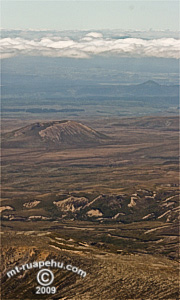Weather on Mt Ruapehu

Landscape Around Mt Ruapehu
There is no denying the fact that Mount Ruapehu is an incomparable outdoor activity destination, but one must also realize its one main caveat, the weather.
New Zealand is very susceptible to eastward moving low-pressure zones from the Tasman Sea, combined with the layout of Mount Ruapehu and geographic features of nearby Tongariro, gives the area a very unique and unpredictable set of weather conditions.
The relative flat area surrounding Mount Ruapehu allows the prevalently westerly winds to funnel around the mountain, creating rain and snowfall over all of Mount Ruapehu’s slopes. The winds also races through the Tama Saddle between Tongariro and Ngaruhoe to create a set of fast winds which dry out the nearby Rangipo Dessert. The wind tunnel effect plays a large role in creating Mount Ruapehu’s desolate look whereby it is a large snow covered mountain, surrounded my scarce dessert.
While Mount Ruapehu experiences mainly Westerly and North Westerly winds, it does occasionally receive gales from the South and East. The typical Westerly winds are normally wetter and are more likely to bring rainfall. Those coming from the East and South are more renowned for their propensity to bring snowfalls.
Mount Ruapehu is an area of high rain and heavy snows. The winds that buffet the mountains not only encircle them but also rise up on their slopes. This forces a large amount of rain to fall on Mount Ruapehu. Annually, the Whakapapa village receives 2200mm of rain and Ohakune measures 1500mm, this is all the more impressive when compared to New Zealand cities like Auckland which average 100-150mm annually.

Landscape on Mt Ruapehu
The temperatures around Mount Ruapehu vary greatly. If the span of a year is taken as measurement, temperatures can be as low as -10° to a rather warm 25° Celsius. The environment on and surrounding Mount Ruapehu does not lead to high humidity, in some instances allowing snow to still be seen in the summer month in secluded low altitude areas and the craters of the volcanoes. In the winter season, snows typically falls to a 1500 meter altitude, although little surprise is held when it descends even lower.
While Mount Ruapehu is an outstandingly beautiful area with an astounding set of weather patterns it is also dangerous, and unfortunately, its unique appeal is the danger itself. Mount Ruapehu is prone to considerable changes in weather, some would go so far as to call it unpredictable, and in some instances even dangerous. Anyone planning to do anything on the mountain, especially at the higher altitudes should play close attention to any weather forecasts, and equip themselves appropriately.





